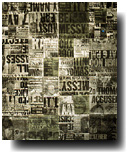
The struggle between icon and alphabet is not, to be sure, anything new, as the history of illuminated manuscripts attests. This complex interaction of word and image never actually vanished; it only fell out of fashion. The tradition of mixing transparent alphabetic information with opaque pictures formed by the letters go back at least to Simias, a Greek poet of the fourth century B.C. It was revived first by Marinetti and then by the Dadaists, with a specifically aggressive purpose. And, to some degree, it lurks in any calligraphic tradition. Electronic display both invites manipulating the icon/alphabet mixture and makes it much easier to write.
We needn't worry about digital determinism. We must explain, instead, the extraordinary convergence of twentieth-century thinking with the digital means that now give it expression. It is the computer as fulfillment of social thought that requires explanation.